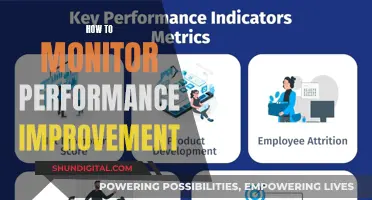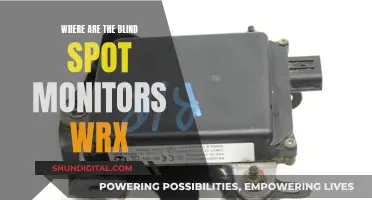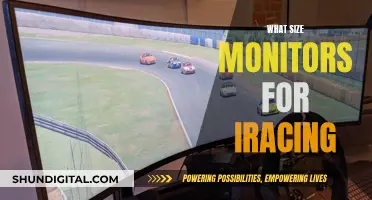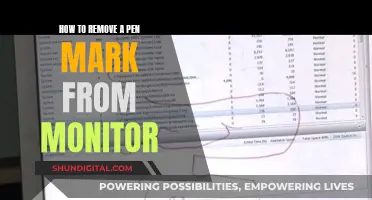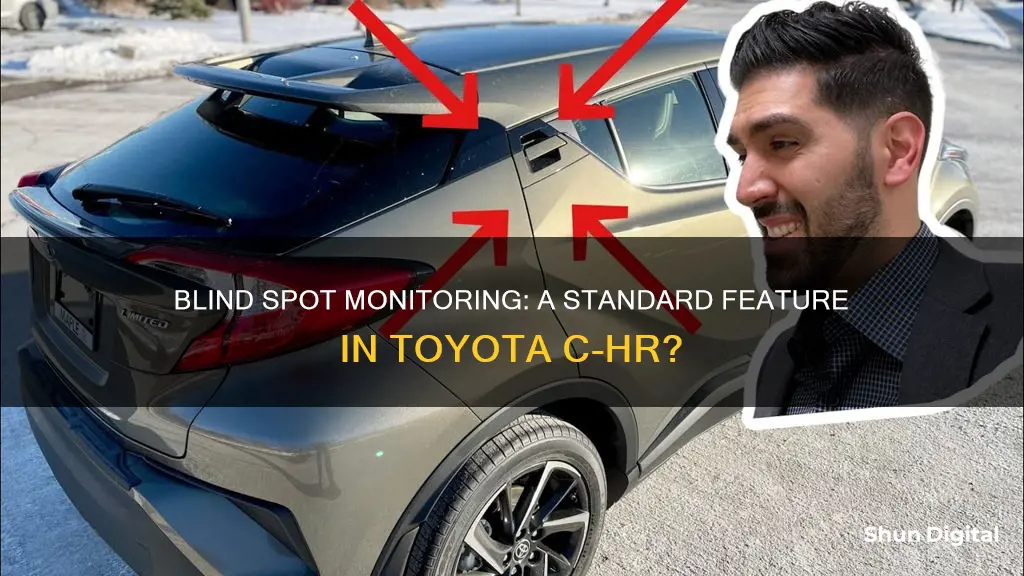
The Toyota C-HR is a unique entry into the crossover SUV segment, offering affordability, efficiency, versatility, technology, and space. The 2018 model includes a Blind Spot Monitor (BSM) with Rear Cross Traffic Alert (RCTA) as part of its Toyota Safety Sense™ P (TSS-P) package. This feature uses sensors to detect vehicles in the driver's blind spot and alerts the driver by lighting up a warning signal on the exterior mirror. The BSM also integrates with the turn signal, causing the light to flash if the driver attempts to change lanes while another vehicle is in their blind spot. The RCTA helps detect vehicles that may be crossing the driver's path when reversing out of a parking spot or driveway. While the BSM and RCTA are available features on the 2019 model, it is unclear whether they come standard on all trims of the 2022 model.
| Characteristics | Values |
|---|---|
| Blind Spot Monitoring | Available as an optional feature |
| Rear Cross-Traffic Alert | Available as an optional feature |
| Year | 2018, 2019, 2022 |
| Warranty | Subject to change without notice and pertains to mainland USA vehicles only |
What You'll Learn

How does Toyota's Blind Spot Monitoring work?
Toyota's Blind Spot Monitoring feature includes a Blind Spot Monitor and Rear Cross Traffic Alert to help detect and alert you to vehicles in your blind spot. This innovative safety feature can be turned on by pressing the BSM button on the dashboard to the left of the steering wheel. You will hear a sound chime and see the lights illuminate on the side mirrors for a few seconds. While driving, if there is a vehicle in your blind spot, the light on that side mirror will light up. If you switch on your turn signal at this time, the light will begin to flash to draw your attention to the vehicle in your blind spot.
The Rear Cross Traffic Alert feature works similarly, detecting vehicles that may be crossing your path when reversing out of a parking spot or driveway. It functions when you're backing up at a speed of 5 mph or less, and it can detect vehicles going between 5 and 18 mph from either side. If a vehicle is detected, the system plays a warning tone and the light in the respective side mirror illuminates.
It is important to remember that while these features can improve safety, they should not be solely relied on. As with any technology, the Blind Spot Monitoring feature has limitations in terms of function, detection, and monitoring range. Drivers must always physically check their blind spots and use their turn signals.
Setting Up a TV Monitor: A Step-by-Step Guide
You may want to see also

How do you turn on the Blind Spot Monitoring feature?
The Blind Spot Monitoring feature in Toyota vehicles includes a Blind Spot Monitor and Rear Cross Traffic Alert to help detect and alert you to vehicles in your blind spot. To turn on the feature, press the BSM button on the dashboard to the left of the steering wheel. You will hear an audible chime and see the lights on the side mirrors illuminate for a few seconds.
While driving, if there is a vehicle in your blind spot, the light on that side mirror will light up. If you switch on your turn signal at this time, the light will begin to flash to draw your attention and let you know there is a vehicle in your blind spot.
The Rear Cross Traffic Alert works in a similar way. It detects vehicles that may be crossing your path when reversing out of a parking spot or driveway. This feature works when you are backing up at a speed of 5 mph or less and can detect vehicles moving between 5 and 18 mph from either side. If a vehicle is detected, the system plays a warning tone and the light in the respective side mirror illuminates.
Please note that while these features can improve safety, they have limitations and should not be exclusively relied upon. Drivers must always look over their shoulder and use their turn signal.
Water Usage Monitoring: A Standard Practice in Hotels?
You may want to see also

What does the Rear Cross Traffic Alert do?
The Rear Cross Traffic Alert (RCTA) is a safety feature available in the Toyota C-HR that helps detect vehicles that may be crossing your path when reversing out of a parking spot or driveway. The RCTA works when you're backing up at a speed of 5 mph or less, and it can detect vehicles approaching from either side at speeds between 5 and 18 mph.
When a vehicle is detected, the RCTA system alerts the driver in two ways. Firstly, a warning tone sounds, and secondly, the light in the respective side mirror illuminates. This provides an excellent level of safety and peace of mind when reversing, as it helps to mitigate the risk of collisions with crossing vehicles.
It's important to note that while the RCTA is a valuable tool, it should not be solely relied upon. Drivers must also physically check their surroundings and use their turn signals when reversing, as the system has limitations in terms of function, detection, and monitoring range.
The RCTA is part of Toyota's Blind Spot Monitoring feature, which includes the Blind Spot Monitor (BSM) and the RCTA. These safety technologies work together to enhance the driver's awareness of their surroundings and help prevent accidents.
Monitor Measurements: Know Your Screen's Dimensions
You may want to see also

What are the limitations of the Blind Spot Monitoring feature?
The Blind Spot Monitoring feature in Toyota vehicles has several limitations that drivers should be aware of. While it is designed to improve safety and assist drivers, it should not be solely relied upon. Here are some of its limitations:
- Function: While the Blind Spot Monitor (BSM) can detect vehicles in the adjacent lanes, it is important to understand that it is not foolproof. The system may not detect all vehicles in the blind spot, especially if they are motorcycles, bicycles, or pedestrians. It is primarily designed to detect other vehicles, and its effectiveness may vary with objects of different sizes and shapes.
- Detection: The BSM relies on sensors to detect objects in the blind spot. These sensors have limitations in terms of range and angle of detection. Objects that are too close or too far from the sensors may not be detected. Additionally, the sensors may not cover the entire blind spot area, so there could be areas that are still not visible to the driver.
- Monitoring Range: The BSM has a limited monitoring range. It is designed to work effectively when the vehicle is travelling at higher speeds, typically on highways. At slower speeds, such as in urban or residential areas, the system may not be as effective, and objects in the blind spot may not be detected.
- Reliability: While the BSM is designed to provide warnings through visual and audio alerts, there is always a possibility of system malfunction or failure. The technology is not perfect, and there could be instances where the system fails to detect objects or provide timely alerts. Therefore, drivers should not solely depend on the BSM and should also perform physical shoulder checks.
- External Factors: The effectiveness of the BSM can be impacted by external factors such as weather conditions, lighting, or road characteristics. For example, heavy rain, snow, or fog may reduce the sensor's ability to detect objects accurately. Similarly, the system may be less effective on roads with multiple lanes or complex intersections where there are more vehicles in close proximity.
In conclusion, while the Blind Spot Monitoring feature in Toyota vehicles can enhance safety and provide drivers with additional information, it should be used as a supplementary tool. Drivers should not become overly reliant on this technology and must continue to follow safe driving practices, including visually checking their blind spots and using turn signals when changing lanes.
Monitoring Internet Usage: Home Hub Parental Controls
You may want to see also

What other safety features does the Toyota C-HR have?
The Toyota C-HR has a host of safety features that make it a dependable and safe vehicle. The 2019 model, for example, has a 5-Star Overall Safety Rating from the NHTSA, and the 2022 model has a host of standard driver-assistance features.
The C-HR has an integrated backup camera, ten standard airbags, and a high-tensile steel body. It also has Toyota's Star Safety System, which includes a pre-collision system with pedestrian detection, lane departure alert with steering assist, automatic high beams, and full-speed range dynamic radar cruise control.
The C-HR also has available blind-spot monitoring and rear cross-traffic alerts, which use sensors to detect objects or vehicles in the driver's blind spot and warn them via a signal on the vehicle's exterior mirror.
Other safety features include LED headlights with an adaptive front-lighting system, dual-zone climate control, and a standard 60/40 split rear seat.
Connecting Audio from Acer Veriton to Monitor: Easy Steps
You may want to see also
Frequently asked questions
Yes, the Toyota C-HR has a Blind Spot Monitor (BSM) with Rear Cross-Traffic Alert (RCTA). The BSM warns you when a vehicle in the next lane enters the C-HR's blind spot on either side of the vehicle.
To turn on the BSM, press the BSM button on the dashboard to the left of the steering wheel. You will hear a sound chime and see the lights illuminate on the side mirrors for a few seconds. While driving, if a vehicle is in your blind spot, the light on that side mirror will light up. If you switch on your turn signal at this time, the light will flash to draw your attention.
The RCTA detects vehicles that may be crossing your path when reversing out of a parking spot or driveway. It works when you’re backing up at a speed of 5 mph or less, and it can detect vehicles going between 5 and 18 mph from the left or right. If a vehicle is detected, the system plays a warning tone and the light in the respective side mirror will illuminate.
The Toyota C-HR has several other safety features, including:
- Standard ten airbags
- Star Safety System™
- Pre-Collision System with Pedestrian Detection
- Lane Departure Alert with Steering Assist
- Automatic High Beams
- Full-Speed Range Dynamic Radar Cruise Control


